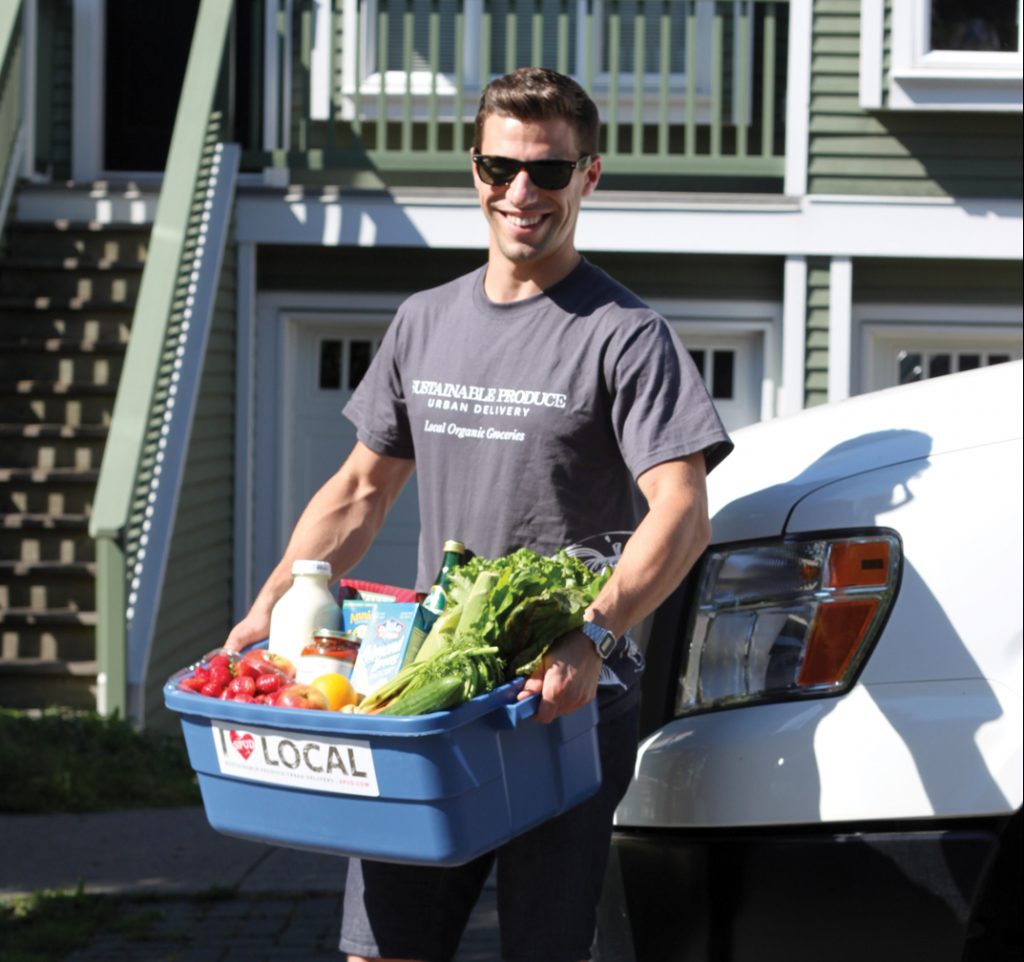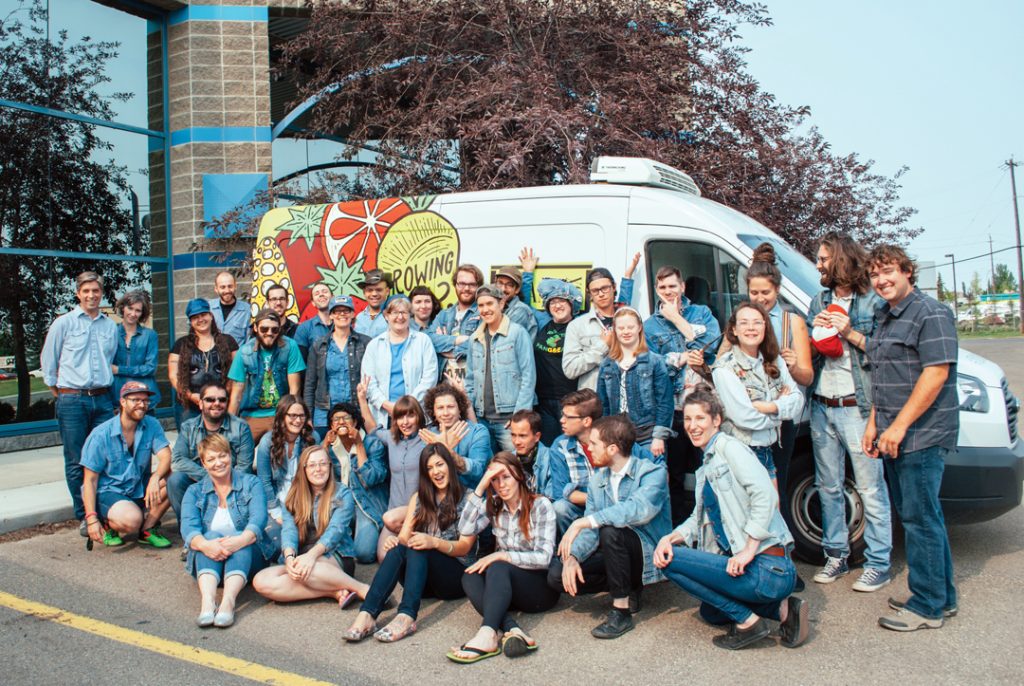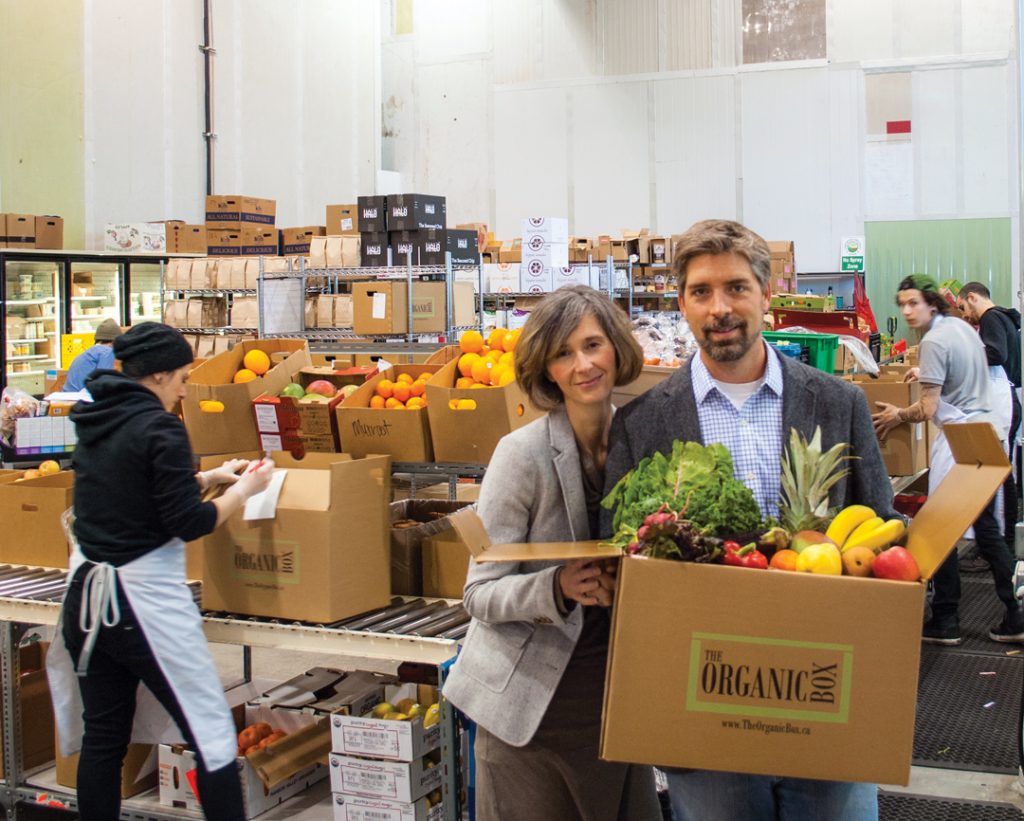GROCERY STORE AT YOUR DOOR
ONLINE SHOPPING FUELS FOOD-DELIVERY REVIVAL
BY TAMARA LEIGH
Krista Ewert was first inspired to try a grocery delivery service when her first child was born. “The idea of going to the grocery store with a baby was not appealing to me,” she said. “So I started ordering from SPUD.ca.”
Sustainable Produce Urban Delivery (SPUD) started delivering groceries in Vancouver in 1997, before expanding to Calgary in 2002 and Edmonton in 2014. Currently, it operates in those three cities, as well as Victoria, Los Angeles and San Francisco. An early entrant into the online grocery market, SPUD has gradually expanded from delivering weekly produce boxes to offering a selection of local produce and grocery items.
Ewert started ordering from SPUD.ca while living in Vancouver, and continued to use the service when she relocated with her family to Edmonton. She enjoys the convenience, and buying online helps her stick to her grocery budget by reducing distractions and impulse buys. In her eight years as a customer, she has developed confidence in the company’s ability to select quality produce as well.
“I can trust SPUD. If I get something and I’m not satisfied, I can call or email them and they’ll refund me,” Ewert said. “One of the great things about SPUD is they tell you about the producers they are buying from. It really helps us choose wisely and be more conscious about our food.”
Ewert’s story is not unique. She is part of a growing number of Canadians who are turning to the Internet for their food needs, whether it is basic grocery supplies, meal kits that can be cooked fresh, or prepared meals from restaurants and retailers.
It’s a market that is segmented based on personal values as much as it is on the value of the food itself.
For SPUD, increasing consumer awareness and demand for local and sustainably produced products is at the heart of the company, and continues to fuel its growth. It works with local farmers, both as customers and partners, to help them extend their growing seasons. The online ordering platform provides customers with detailed information for each product, including the farmers SPUD works with, the distance products travel to the distribution centre and nutritional information.
“Our relationship with our customers is based on trust and price, in that order,” said Corbin Bourree, managing director for SPUD’s Edmonton operations. “Everyone has a million questions about how delivery works, what happens if it’s not perfect. The web experience does a good job of providing customers with enough information that they know what to expect and can trust the process.
“Beyond that, it comes down to value. The products that we carry are healthy and local. You are buying products you can feel good about. We’re going to give you good value because we want it to be a service that as many people can access as possible,” he added.
SPUD is focusing on consumers like Ewert who are invested in the quality of the food they are serving their families, busy professionals who don’t have time to shop during the week, and people with mobility challenges who appreciate the convenience of having food delivered.
SPUD currently delivers to 2,000 regular customers in Edmonton and 4,000 in Calgary. Within a month of their first order, 70 per cent of customers return and more than 50 per cent will carry on as long-term shoppers.
EXPANDING THE RETAIL BASE
“Home delivery is not a new concept, it’s been around for decades. What is happening is the concept is increasingly becoming embedded in the strategy for growth,” said Sylvain Charlebois, dean of the faculty of management and agriculture professor at Dalhousie University. “Location is key, but also limiting. Delivery is one way to increase the accessible market for any retailer to extend their footprint beyond the borders of their store.”
On a local level, many smaller farmers have turned to community-supported agriculture (CSA) models to expand their retail footprint and reach beyond the farmers market. Danny and Miranda Turner took that enterprising spirit to the next level with The Organic Box.
In 2010, the Turners partnered with four farms in northern Alberta to offer a vegetable box distribution program to 100 families in Edmonton. The modified-CSA program also provided distribution for fruit from the Turners’ orchard in Creston, B.C. When they decided to expand to a year-round program, they had to look at different ways of making the business sustainable.
“Bananas and avocados are two top-selling items in Canadian produce markets, so we made a decision to include all produce options for our customers,” said co-founder Danny Turner. “We started a produce importing and distribution company, and used the bananas to help sell our own potatoes.”
Today, The Organic Box represents 75 growers and producers from across Western Canada. The company offers over 2,000 grocery items, and delivered to more than 12,000 families last year. The products that it can’t source from local growers are imported from organic producers elsewhere, providing an economic benefit to their own communities no matter where in the world they farm.
“Our model is based around a virtual farmers market. You won’t see national brands in our catalogue because we want to represent producers and businesses like us,” Turner said. “Getting your food delivered is a convenience thing, but we differentiate ourselves with our transparency and connection to the source. I’m not concerned about the major retailers because when people buy food from us they are buying from the farmers.”
It’s a point of differentiation that is appreciated by consumers and producers alike.
“I really like SPUD and Organic Box because of their focus on ‘local,’ and I love that we can get such good-quality ingredients delivered to the door,” said Gail Hall, owner of Seasoned Solutions Loft Cooking School and Culinary Tours in Edmonton. She has used both services, for her personal use and to order ingredients for cooking classes.
“A lot of producers don’t have the know-how to market what they make,“ she said. “They are more concerned about growing what they grow and doing it well. These services help them get their products to the consumer.”
CANADIANS COOL TO ONLINE FOOD PURCHASING
Canadians, however, have been slow to catch on to the online food trend compared with our American counterparts. Online food purchases currently account for about one per cent of the total value of the grocery sector here, compared to four per cent in the United States.
“When it comes to food retailing, you are still dealing with a highly traditional sector, but it has really been showing signs of transformation in recent years,” Charlebois said. “We are seeing companies hiring people from outside the grocery business. They are embracing changes and trying to follow what consumers are looking for.”
While independent providers like SPUD and The Organic Box have done well in local markets so far, major retailers are making big moves into online shopping by offering pick-up, delivery or both. Loblaws, Sobeys and Save-On-Foods are piloting online shopping and delivery options in markets across the country, and mega-retailer Wal-Mart is making an aggressive push into the market as well.
Pressure is also building from the technology sector, where online retail and delivery infrastructure has been honed. Tech companies are now moving into food delivery through services like AmazonFresh, which delivers grocery items; UberEATS, targeting restaurant delivery; and online shopping service Google Express, which started delivering fresh groceries in select U.S. cities in February. These services are currently being piloted in the Toronto area, but have not yet made their way into Western Canada.
“Canada is a market where people aren’t used to buying food online. If you look around at other places around the world, online food purchasing is the way that things are going,” Bourree said. “Online purchases account for more than 20 per cent of all food purchased in the U.K., 23 per cent in Korea and more than 15 per cent in New York City. We [at SPUD] believe it’s a growing trend that will continue into the future.”
With major food retailers entering this once-niche space, people like Turner are optimistic that their hyper-local connection between farmers and consumers will sustain them. The Organic Box’s operations have also recently diversified to include food processing and distribution.
“In our direct-to-consumer business, we are feeling the challenge of major retailers coming in, but we are up to the challenge because we know our products and service stand apart,” Turner said. “We have expanded our model to include selling to major retailers, so it’s still an opportunity for us.”
THE EVOLUTION OF CONVENIENCE FOOD
As food purchasing and delivery options diversify, so do the offerings available to consumers. Chef’s Plate in Toronto offers gourmet meal kits for delivery anywhere in Ontario. Consumers are able to order from a menu of meal options, and receive a box filled with prepared and portioned fresh ingredients. At $10.95 per portion, the service provides quick, fresh, healthy and affordable alternatives to restaurant or ready-to-heat meals.
“As food evolves, everything is getting broader and more personal at the same time,” said Calgary-based food and restaurant writer John Gilchrist. “Twenty years ago, you went to the grocery store or you went out to eat. Now you can go online to order grilled salmon with watercress, and all ingredients will be delivered to the door tomorrow.”
The Chef’s Plate model builds on the success of companies like Blue Apron, which delivers three million meals per month across the United States, and HelloFresh, which surpassed four million meals per month in mid-2015. Chef’s Plate won’t talk dates for any forays into markets beyond Ontario, but the company is expected to expand to other parts of Canada later in 2016.
“On the whole, it’s about the diversification of the industry. People find niches that will fill other people’s desires and they go for it. It helps broaden our palate a bit because we end up trying different things,” Gilchrist said of the food-delivery business model. “The way our economy is right now, I don’t know how well they are doing. At the other end of the scale, we have community kitchens that are trying to help people learn how to cook and prepare value-focused meals.”
Aside from the convenience factor, ready-to-assemble meals offer an intermediate step for people who want to get more familiar with cooking techniques or who want to learn to work with different ingredients. “We are not necessarily taught to cook by our mothers and grandmothers anymore, and we don’t always teach it in schools, so many people don’t really know how to cook,” Hall said.
“A lot of people say ‘I don’t have time to go shopping’ or ‘I don’t have time to look for these things.’ If it was brought to their door and they had enough confidence to put it together, more food delivery will result in more people wanting fresh, healthy food.”











Comments